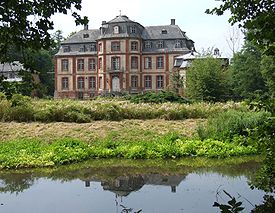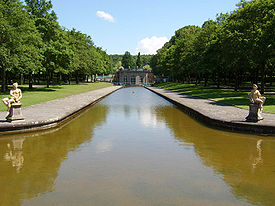
François de Cuvilliés
Encyclopedia

Bavaria
Bavaria, formally the Free State of Bavaria is a state of Germany, located in the southeast of Germany. With an area of , it is the largest state by area, forming almost 20% of the total land area of Germany...
n decorative designer and architect who was instrumental in bringing the Rococo
Rococo
Rococo , also referred to as "Late Baroque", is an 18th-century style which developed as Baroque artists gave up their symmetry and became increasingly ornate, florid, and playful...
style to the Wittelsbach
Wittelsbach
The Wittelsbach family is a European royal family and a German dynasty from Bavaria.Members of the family served as Dukes, Electors and Kings of Bavaria , Counts Palatine of the Rhine , Margraves of Brandenburg , Counts of Holland, Hainaut and Zeeland , Elector-Archbishops of Cologne , Dukes of...
court at Munich
Munich
Munich The city's motto is "" . Before 2006, it was "Weltstadt mit Herz" . Its native name, , is derived from the Old High German Munichen, meaning "by the monks' place". The city's name derives from the monks of the Benedictine order who founded the city; hence the monk depicted on the city's coat...
and to Central Europe
Central Europe
Central Europe or alternatively Middle Europe is a region of the European continent lying between the variously defined areas of Eastern and Western Europe...
in general.
Cuvilliés was so diminutive in stature that it was as a court dwarf
Court dwarf
Early dwarfs, whose histories were recorded, were sometimes employed as Court Dwarfs. They were owned, exploited, and traded amongst people of the court, and delivered as gifts to fellow kings and queens. Ancient Egypt saw dwarfs as being people with significant sacred associations, so owning a...
he first came to the notice of the currently exiled Max Emanuel, Elector of Bavaria
Maximilian II Emanuel, Elector of Bavaria
Maximilian II , also known as Max Emanuel or Maximilian Emanuel, was a Wittelsbach ruler of Bavaria and an elector of the Holy Roman Empire. He was also the last Governor of the Spanish Netherlands and duke of Luxembourg...
, who detected the young dwarf's aptitude and had him tutored in mathematics, then underwrote his further education with Joseph Effner
Joseph Effner
Joseph Effner was a German architect and decorator.Effner was born in Dachau as a son of the court gardener Christian Öffner. Effner accompanied the elector of Bavaria Max Emanuel to Bruxelles. In 1706 Effner was retrained by Gabriel Germain Boffrand in Paris. Here he changed his family name to...
and sent him to Paris, 1720-24, where he trained in the atelier of Jean-François Blondel, On his return to Munich he was appointed court architect, at first in conjunction with Effner.
At the Elector's death in 1726, for a time Cuvilliés worked at Schloss Brühl
Augustusburg and Falkenlust Palaces, Brühl
The Augustusburg and Falkenlust palaces is a historical building complex in Brühl, North Rhine-Westphalia, Germany, which have been listed as a UNESCO cultural World Heritage Site since 1984. They are connected by the spacious gardens and trees of the Schlosspark.Augustusburg Palace and its parks...
for the new Elector's brother, Clemens August of Bavaria
Clemens August of Bavaria
Clemens August of Bavaria was a member of the Wittelsbach dynasty of Bavaria and Archbishop-Elector of Cologne.-Biography:...
. He provided designs for the chapel at Brūhl, (1730-40) and the hunting lodge Falkenlust
Augustusburg and Falkenlust Palaces, Brühl
The Augustusburg and Falkenlust palaces is a historical building complex in Brühl, North Rhine-Westphalia, Germany, which have been listed as a UNESCO cultural World Heritage Site since 1984. They are connected by the spacious gardens and trees of the Schlosspark.Augustusburg Palace and its parks...
(1729-40) but as Charles Albert's
Charles VII, Holy Roman Emperor
Charles VII Albert a member of the Wittelsbach family, was Prince-elector of Bavaria from 1726 and Holy Roman Emperor from 24 January 1742 until his death in 1745...
interests shifted to Munich, he also returned to Munich. There his fame was established by the decors of the Reiche Zimmer in the Munich Residenz
Residenz, Munich
The Munich Residenz is the former royal palace of the Bavarian monarchs in the center of the city of Munich, Germany...
, which had been damaged by a fire, 14 December 1729. The contents of the Schatzkammer fortunately had been spared, and Cuvilliés was commissioned to design the panelling of a new interior, to be executed by the court's premier carver Joachim Dietrich. with four rococo
Rococo
Rococo , also referred to as "Late Baroque", is an 18th-century style which developed as Baroque artists gave up their symmetry and became increasingly ornate, florid, and playful...
gilded console tables on scrolling legs with playful dragons.
His masterpiece is the Amalienburg in the park at Nymphenburg, built 1734-39, with silvered or gilded naturalist Rococo decorations set off by coloured grounds. As the 1911 Encyclopaedia Britannica commented, "his style, while essentially thin, is often painfully elaborate and bizarre. He designed mirrors and consoles, balustrades for staircases, ceilings and fireplaces, and in furniture, beds and commodes especially".
The Residenztheater, or "Cuvilliés Theatre
Cuvilliés Theatre
The Cuvilliés Theatre or Old Residence Theatre is the former court theatre of the Residenz in Munich, southern Germany.- Description :...
" (1751-1755) designed and constructed for Elector Max III Joseph
Maximilian III, Elector of Bavaria
Maximilian III Joseph was Prince-elector of the Holy Roman Empire and Duke of Bavaria from 1745 to 1777.-Biography:...
by Cuvilliées; though the theatre was bombed during World War II, the carved and gilded boxes had been dismantled and stored for security. Afterwards the Residenztheatre was meticulously recreated in the 1950s.

Munich
Munich The city's motto is "" . Before 2006, it was "Weltstadt mit Herz" . Its native name, , is derived from the Old High German Munichen, meaning "by the monks' place". The city's name derives from the monks of the Benedictine order who founded the city; hence the monk depicted on the city's coat...
. From 1738 he embarked on his life-long series of suites of engravings of wall-panelling, cornices, furniture and wrought-iron work, which were then published in Munich and distributed in Paris and doubtless elsewhere; they served to disseminate the Rococo throughout Europe.
Chief works
- Palace in BrühlAugustusburg and Falkenlust Palaces, BrühlThe Augustusburg and Falkenlust palaces is a historical building complex in Brühl, North Rhine-Westphalia, Germany, which have been listed as a UNESCO cultural World Heritage Site since 1984. They are connected by the spacious gardens and trees of the Schlosspark.Augustusburg Palace and its parks...
(1728 bis 1740) - Palais Piosaque de Non (1729; destroyed) in Munich
- Wilhelmsthal Palace (1744) in KasselKasselKassel is a town located on the Fulda River in northern Hesse, Germany. It is the administrative seat of the Kassel Regierungsbezirk and the Kreis of the same name and has approximately 195,000 inhabitants.- History :...
- Upgrading of the Munich ResidenceResidenz, MunichThe Munich Residenz is the former royal palace of the Bavarian monarchs in the center of the city of Munich, Germany...
(1730-1737), including construction of the Cuvilliés TheatreCuvilliés TheatreThe Cuvilliés Theatre or Old Residence Theatre is the former court theatre of the Residenz in Munich, southern Germany.- Description :...
(1750-1753) - Palais HolnsteinPalais HolnsteinThe Palais Holnstein is a historical building in Munich, southern Germany, which has been the residence of the Archbishop of Munich and Freising since 1818....
in Munich (1733-1737) - AmalienburgAmalienburgThe Amalienburg is a small hunting lodge in the Nymphenburg Palace of Munich, southern Germany. It was constructed in 1734-1739 by François de Cuvilliés, in Rococo style, for the Holy Roman Emperor Charles VII and his wife, Maria Amalia of Austria....
in the park of Nymphenburg PalaceNymphenburg PalaceThe Nymphenburg Palace , i.e. "Nymph's Castle", is a Baroque palace in Munich, Bavaria, southern Germany. The palace was the main summer residence of the rulers of Bavaria.-History:...
(1734-1739) - Facade of the Theatiner Church (1768)

